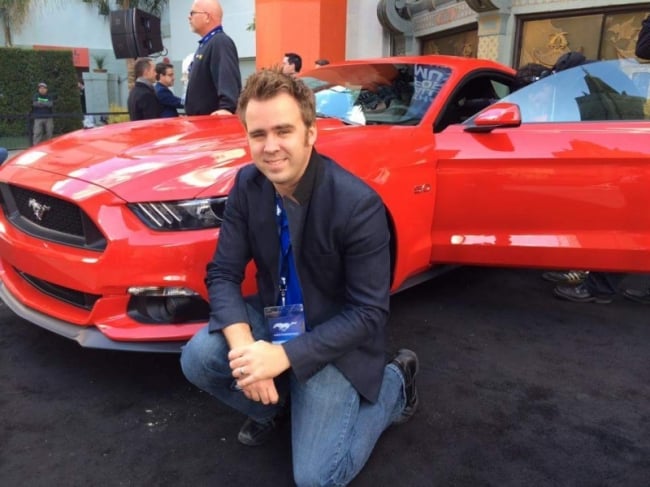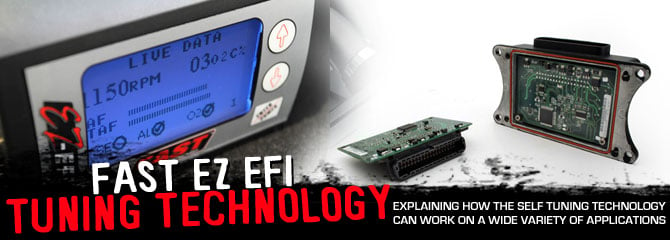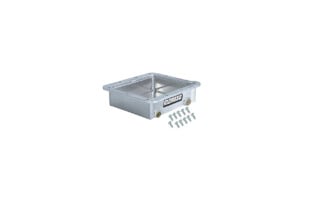While you could spend a lifetime learning how to tune a carburetor, getting a car running reasonably well with one can be as simple as picking the right carb and bolting it on. Not so with fuel injection – switching a classic musclecar from carburetion to EFI is at task best left to the experts and their laptops. Or at least it was, before FAST introduced their new EZ EFI system. Now, practically anyone can experience the benefits of better gas mileage and drivability that come with fuel injection, without all the headaches. Thanks to the FAST EZ EFI’s self-tuning technology, converting a carbureted car to fuel injection, and more importantly getting it to run like you want it to, has never been easier.
EFI to Carb and Back Again
Our test mule, the “Riced Rat Rod”, is a Nissan 240SX that’s been an experimental subject on many different fronts, though it has always been powered by a carbureted 400ci small block Chevy since we started messing with it. The 240SX is a light, Tremec TKO-600-equipped vehicle that makes 425 HP to the rear wheels. Since it sees a lot of driving on the street, we figured the EZ EFI could help make this moderately-cammed Chevy a little more livable in daily driving. It seems a bit ironic that we took a factory fuel injected car to a carburetor, and then back to fuel injection, but it makes perfect sense in this case.
Along with the EZ EFI we installed a complete ignition system from Mallory. Though the EZ EFI doesn’t require an aftermarket ignition – even a stock-style distributor will work – we took the opportunity to upgrade in this area as well. We opted for the EZ EFI Master Kit that includes a fuel pump, filter, lines, fittings, wiring harness, regulator, and fuel pressure gauge. Again, you don’t need the master kit to use the EZ EFI (though it makes the installation much easier than sourcing the individual parts) but you do need a return-style high pressure fuel system – the low pressure carbureted counterpart won’t cut it.
The first part is getting the new FAST throttle body installed. It utilizes all the same mounting points as a 4150-style 4-barrel carburetor, so even the throttle return spring is a direct fit. All of the electrical connections are labeled, and the majority of them plug directly into the throttle body. The wide-band O2 sensor that allows the EZ EFI system to tune itself goes in the header collector, but since we already had the FAST Budget Wide Band system installed (which uses the same kind of sensor) we only had to plug the EFI connector in. The other external sensor is for coolant temperature, which we installed in the intake manifold next to the water neck and opposite of our Auto Meter water temperature sensor.

The FAST throttle body bolts on just like a carburetor, though the wiring harness for the injectors, throttle position sensor, and intake air temperature sensor has to be plugged in as well. External connections for power, coolant temperature, the wideband O2 sensor, and RPM signal complete the wiring for the EZ EFI system.
The wiring is extremely simple. Heavy-gauge black and red wires for power and ground must be routed directly to the battery to avoid any electrical noise problems. As we said before, the Master Kit includes a plug-and-play fuel pump relay harness that snaps into place and only requires a power wire connected to the fuel pump. The RPM input is one of the most important sensors and hooks directly to your ignition box output, or there is a signal converter for HEI-equipped vehicles included with the kit. All that is left is the serial cable plug for the display, the display power connection, and a wire to a 12 volt switched source that will turn the ECU on. There are also ground circuit provisions for A/C-equipped cars to raise your idle speed when the compressor is running, and an electric fan control with an adjustable activation temperature controlled by the ECU.
We installed the new fuel pump in place of the low-pressure electric unit we had originally installed for the V8 conversion, then ran the supply and return lines. The fuel pump comes with its own harness that’s grounded at the pump and connects on the power side directly to the EZ EFI fuel pump harness. We did need one more fitting for our 15 gallon, trunk mounted fuel cell to connect the return line. Once in place, all the lines were wrapped in Heatshield Products velcro sheath to keep our fuel as cool as possible.
Once everything is connected and plumbed, it’s time to turn the system on and begin the setup. A simple menu screen asks you questions like the size of your engine, idle speed, fuel pressure, and number of cylinders. It will then prompt you to calibrate the TPS in idle and wide open throttle, which we obviously did with the engine not running. With the initial setup complete, we crossed our fingers, then cranked the SBC over and it fired almost instantly. The display will give you a target window to adjust your idle speed to by using the idle set screw on the throttle body, which is in the same place as it is on a 4150 carb. Once the idle is calibrated, further adjustment can be done directly through the hand-held display.

The included fuel supply and return lines were wrapped in Heatshield Products sheath to keep our fuel cool.
Tuning Tweaks
The beauty of the EZ EFI system is that it learns as it works, tuning and continually refining itself as you drive. That doesn’t mean you can’t help the computer out, though. Since the 240SX is a light car with a big engine, it requires very little gas pedal effort to get the car rolling. During these light throttle situations, we noticed the engine wanted to run rich and bog momentarily. An “accel fuel” option you can adjust in the ECU works just like a carburetor accelerator pump, and by pulling a few percent out, were able to make the vehicle run perfectly under those light throttle transitions.
An interview with David Page – FAST EZ EFI Engineer – The Technology Behind the Self Tuning Capability
powerTV: For those who aren’t familiar with electronic fuel injection, a system that you can just bolt on that tunes itself seems like magic. Can you give us an overview of how the EZ EFI works?
David Page: “It starts out with basic closed loop operation, which is nothing new – it has been the basis of EFI operation for a long time. It uses a wide band O2 sensor, and it compares the target air/fuel ratio that is set inside the ECU to the actual air fuel ratio the vehicle is producing. It then adds or subtracts a correction amount to make those two numbers match. What is unique about the EZ EFI is that it takes that percentage and makes a fuel map based on the correction. Essentially it builds a new map for that engine and application so that it operates at zero, or near to zero correction factor.”
powerTV: The EZ EFI uses far fewer sensors than a factory computer, though it gains in air/fuel monitoring accuracy by having a wide band sensor instead of an OEM’s narrow band. What is the biggest difference between engineering a universal kit like this versus an OEM application?
David Page: “The wide band is the primary difference. Also, the OEM’s spend thousands of hours calibrating each system. They can run a narrow band sensor because they only need to correct within a narrow range, due to all that calibration R&D. It is very specific on how that application will be used, whereas one engine could be 302 cubic inches in a street car or 500 cubic engines on an air boat when using an EZ EFI system. The wide band allows for a much wider tuning window. If you let the EZ EFI tune itself in all the possible load and RPM ranges, you could essentially turn the O2 sensor off and as long as nothing failed in the fuel delivery, would run perfectly fine.”
powerTV: Obviously the EZ EFI is aimed at a different customer than your previous EFI systems. What is the difference in the components compared to a high-end standalone like the XFI?
David Page: “The EZ EFI uses all the same primary sensors that you would find in any high-end standalone. Consequently, some of the exact same sensors are shared between them. The one thing it does not control is the ignition, so we could offer this kit at very affordable price. Also it comes down to simplicity. When installing an EZ EFI kit, the ignition stays completely untouched other than the RPM input wire.”
powerTV: When going through the easy setup wizard, what is the computer doing differently between the different engine combinations to build an initial running tune?
David Page: “The EZ EFI is a true speed-density application, and the heart of it is to estimate the mass of the air (volume and density) that is moving through the engine. Once that is known and you give it a target air/fuel ratio, it knows the mass of fuel it needs to put in the engine by the percentage of pulse width on a given injector. But it starts with estimating the air. So it needs to know the potential volume of the engine. A 400 cubic inch engine has the potential to displace a volume of that 400 cubic inches of air in one given cycle. When you change that number, you change a variable in the programming of the ECU.”

The advanced options menu allows you to adjust the target air fuel ratio at several operating points.
powerTV: The EZ EFI system has a lot of built-in troubleshooting functions to diagnose sensor errors, and it can get you home even if there are problems like that, but the instructions state that the engine cannot run whatsoever without a RPM input. Why is that reading so important?
David Page: “It has the biggest impact on fueling changes. Without RPM, it will only find one pulse width -the idle value. This value, if unchanged under acceleration, will not allow the vehicle to run. On the other hand, if you have a value that would allow the motor to run at part throttle, it would flood the motor out at idle. It would be like having a carburetor with just the main jets flowing fuel, or trying to run wide open off the idle circuits.”
powerTV: It seems like, “just start it up and drive it for a while” is almost too simple. What are your top tips when it comes to getting the EZ EFI to learn a vehicle properly?
David Page: “The more random the better – it’s all about just hitting the streets. The beauty of it is that you can actually feel and hear the engine smooth out as it learns the specific areas. If you have a vehicle that has low idle vacuum, let it learn the idle first in your driveway. The wide open throttle portion is the easiest part of the learning for the ECU. Two or three wide open throttle blasts, and it will learn the wide open portion. Put the vehicle in the RPM ranges and situations in which you are mainly at the most.”

The EZ EFI display shows real time wideband readings versus the target air/fuel ratio, and the correction factor between the two. As the ECU learns the vehicle, the correction factor will approach 0%.
powerTV: So what’s the reason for the 600 horsepower limit on the EZ EFI system? How about alternative fuels?
David Page: “It really comes down to just the four 88 lb/hr injectors that are on the system. Right now its a limitation of the availability for a larger injector to fit in that compact size. Also, a really high flow rate injector will change the fuel distribution and atomization characteristics. Not only does this limit the horsepower, but also the fuel type you can use. Though the system could function with E85, you would be limited to about 300 horsepower due to all the additional fuel volume you would need. Also, there isn’t any custom fuel mapping currently configured for E85 so that isn’t an option at this time.”
powerTV: Are there any special considerations on engine modifications when it comes to running an EZ EFI system? Do certain intakes, heads, or cams work better than others?
David Page: “While it works with a single or dual plane manifold, fuel distribution is much better with a dual plane. As far as manifold vacuum goes with an aggressive cam (less than 7-8 inches vacuum at idle), the more patient you will have to be with it learning the idle fuel curve. You need to set your initial target idle high, then slowly let it down.”

The EZ EFI system is also available with a dual quad setup that will support as much as 1200 horsepower.
powerTV: By going to the dual quad setup (with four EZ EFI throttle bodies), what changes from a programing perspective?
David Page: “Mainly it is just the injector difference by adding four more for a total of eight. The pulse width will now be cut in half with those included injectors. That is the only difference.”
powerTV: Now that FAST has both the high end of the EFI market covered with the XFI system, and the entry level taken care of with EZ EFI, do you foresee something in the middle ground, perhaps with integrated ignition control?
David Page: “There is definitely going to be one new product introduced in that area. For certain we will carry the self-tuning functionality over to any other ECU we develop, even if it’s a high end system. We definitely welcome input from anyone on what they think is a real need out there in that range.”
EZ Does it in One Day
The EZ EFI system is an extremely versatile system for virtually for anyone that is looking to switch from traditional carburetor, or even as a controller for currently fuel injected cars. All you need to do is answer a few basic questions and the EZ EFI does the rest. No more laptop or expensive tuning sessions are required – everything you need is right there inside, waiting to learn.






















